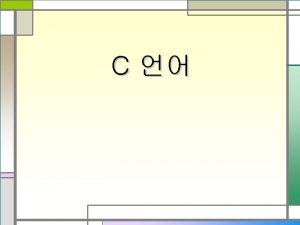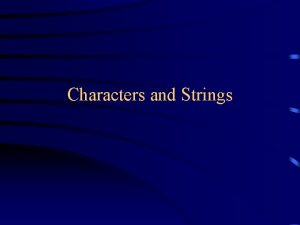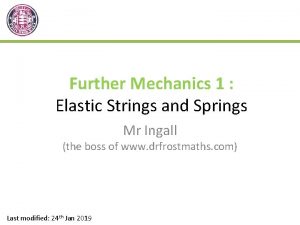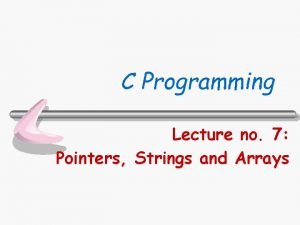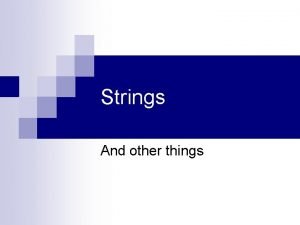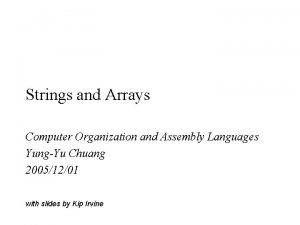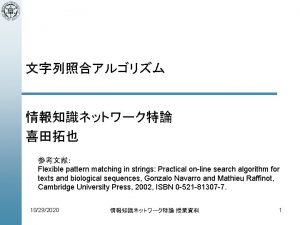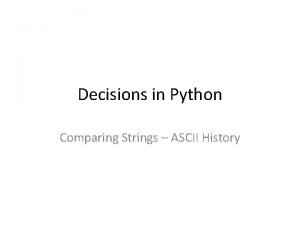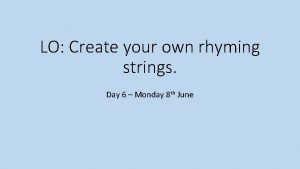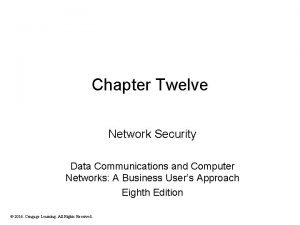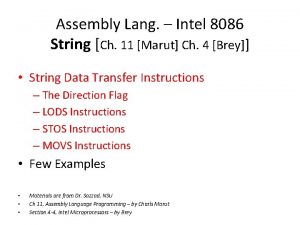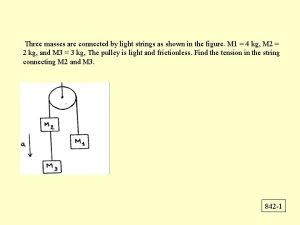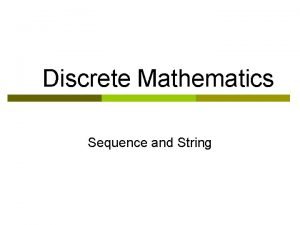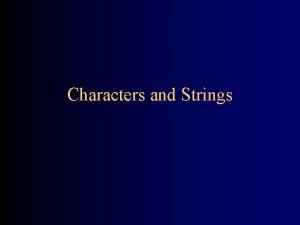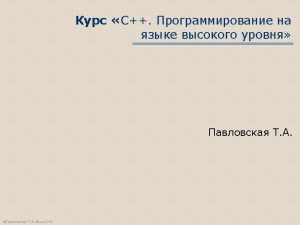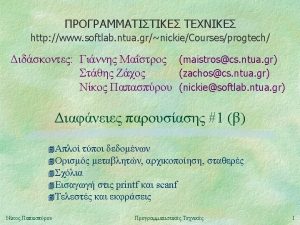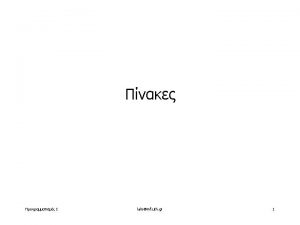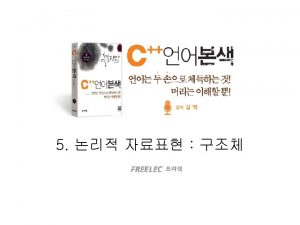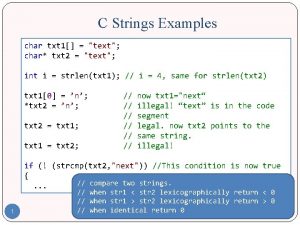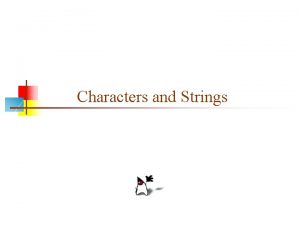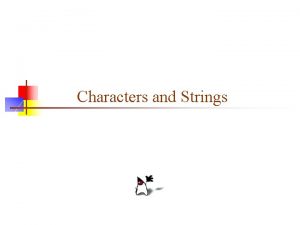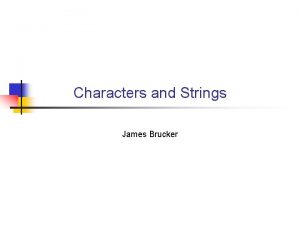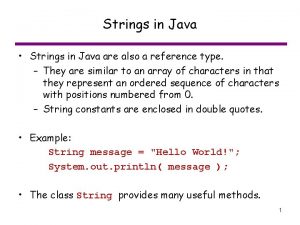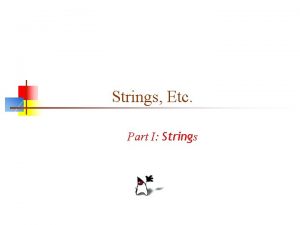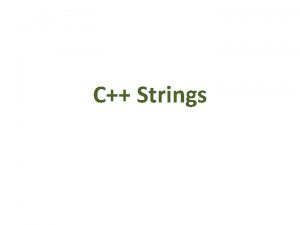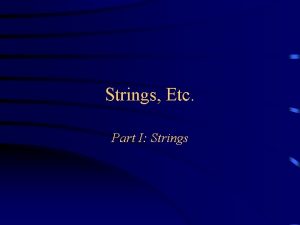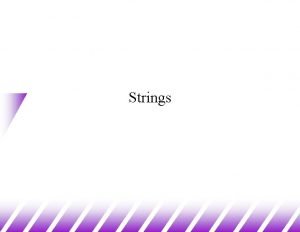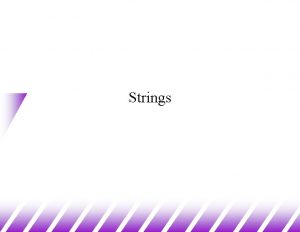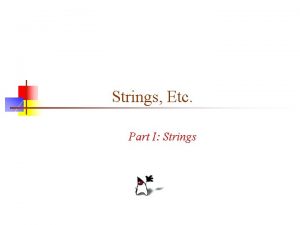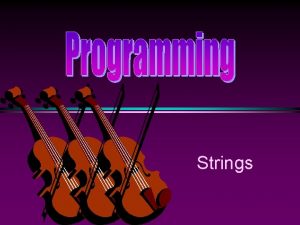Characters and Strings Characters In Java a char


















- Slides: 18

Characters and Strings

Characters • In Java, a char is a primitive type that can hold one single character • A character can be: – A letter or digit – A punctuation mark – A space, tab, newline, or other whitespace – A control character • Control characters are holdovers from the days of teletypes

char literals • A char literal is written between single quotes: 'a' 'A' '5' '? ' '' • Some characters cannot be typed directly and must be written as an “escape sequence”: – Tab is 't' – Newline is 'n' • Some characters must be escaped to prevent ambiguity: – Single quote is ''' (quote-backslash-quote) – Backslash is '\'

Additional character literals n newline t tab b backspace r return f \ ' " form feed backslash single quote double quote

Character encodings • A character is represented as a pattern of bits • The number of characters that can be represented depends on the number of bits used • For a long time, ASCII (American Standard Code for Information Interchange) has been used • ASCII is a seven-bit code (allows 128 characters) • ASCII is barely enough for English – Omits many useful characters: ¢ ½ç“”

Unicode • Unicode is a new 16 bit (two byte) standard that is designed to replace ASCII • “Unicode provides a unique number for every character, no matter what the platform, no matter what the program, no matter what the language. ” • Java uses Unicode to represent characters – You should know that Java uses Unicode, but – Except for having these extra characters available, it seldom makes any difference to how you program

Unicode character literals • The rest of the ASCII characters can be written as octal numbers from � to 377 • Any Unicode character can be written as a hexadecimal number between u 0000 and u. FFFF • Since there are over 64000 possible Unicode characters, the list occupies an entire book – This makes it hard to look up characters • Unicode letters in any alphabet can be used in identifiers

Glyphs and fonts • A glyph is the printed representation of a character • For example, the letter ‘A’ can be represented by any of the glyphs A A • A font is a collection of glyphs • Unicode describes characters, not glyphs

Strings • A String is a kind of object, and obeys all the rules for objects • In addition, there is extra syntax for string literals and string concatenation • A string is made up of zero or more characters • The string containing zero characters is called the empty string

String literals • A string literal consists of zero or more characters enclosed in double quotes "" "Hello" "This is a String literal. " • To put a double quote character inside a string, it must be backslashed: ""Wait, " he said, "Don't go!"" • Inside a string, a single quote character does not need to be backslashed (but it can be)

String concatenation • Strings can be concatenated (put together) with the + operator "Hello, " + name + "!" • Anything “added” to a String is converted to a string and concatenated • Concatenation is done left to right: "abc" + 3 + 5 gives "abc 35" 3 + 5 + "abc" gives "8 abc" 3 + (5 + "abc") gives "35 abc"

Newlines • The character 'n' represents a newline • When “printing” to the screen, you can go to a new line by printing a newline character • You can also go to a new line by using System. out. println with no argument or with one argument • When writing to a file, you should avoid n and use System. out. println instead – I’ll explain this when we talk about file I/O

System. out. print and println • System. out. println can be called with no arguments (parameters), or with one argument • System. out. println is called with one argument • The argument may be any of the 8 primitive types • The argument may be any object • Java can print any object, but it doesn’t always do a good job – Java does a good job printing Strings – Java typically does a poor job printing types you define

Printing your objects • In any class, you can define the following instance method: public String to. String() {. . . } • This method can return any string you choose • If you have an instance x, you can get its string representation by calling x. to. String() • If you define your to. String() method exactly as above, it will be used by System. out. print and System. out. println

Constructing a String • You can construct a string by writing it as a literal: "This is special syntax to construct a String. " • Since a string is an object, you could construct it with new: new String("This also constructs a String. ") • But using new for constructing a string is foolish, because you have to write the string as a literal to pass it in to the constructor – You’re doing the same work twice!

String methods • This is only a sampling of string methods • All are called as: my. String. method(params) – length() -- the number of characters in the String – char. At(index) -- the character at (integer) position index, where index is between 0 and length-1 – equals(another. String) -- equality test (because == doesn’t do quite what you expect • Don’t learn all 48 String methods unless you use them a lot--instead, learn to use the API!

Vocabulary • escape sequence -- a code sequence for a character, beginning with a backslash • ASCII -- an 7 -bit standard for encoding characters • Unicode -- a 16 -bit standard for encoding characters • glyph -- the printed representation of a character • font -- a collection of glyphs • empty string -- a string containing no characters • concatenate -- to join strings together

The End
 Const table
Const table Ontinue
Ontinue Strings in java
Strings in java Java char literals
Java char literals Springs and strings
Springs and strings Pointers and strings
Pointers and strings Strings and other things
Strings and other things Strings in assembly language
Strings in assembly language Flexible pattern matching in strings
Flexible pattern matching in strings Rate of energy transfer by sinusoidal waves on strings
Rate of energy transfer by sinusoidal waves on strings Compare strings python
Compare strings python Describe the sound of the instrument of afiw
Describe the sound of the instrument of afiw Michael league bass strings
Michael league bass strings Rhyming strings
Rhyming strings A type of cipher that uses multiple alphabetic strings
A type of cipher that uses multiple alphabetic strings Cld in 8086
Cld in 8086 Achievement standards network
Achievement standards network Three masses are connected by strings
Three masses are connected by strings Sequence discrete math
Sequence discrete math

